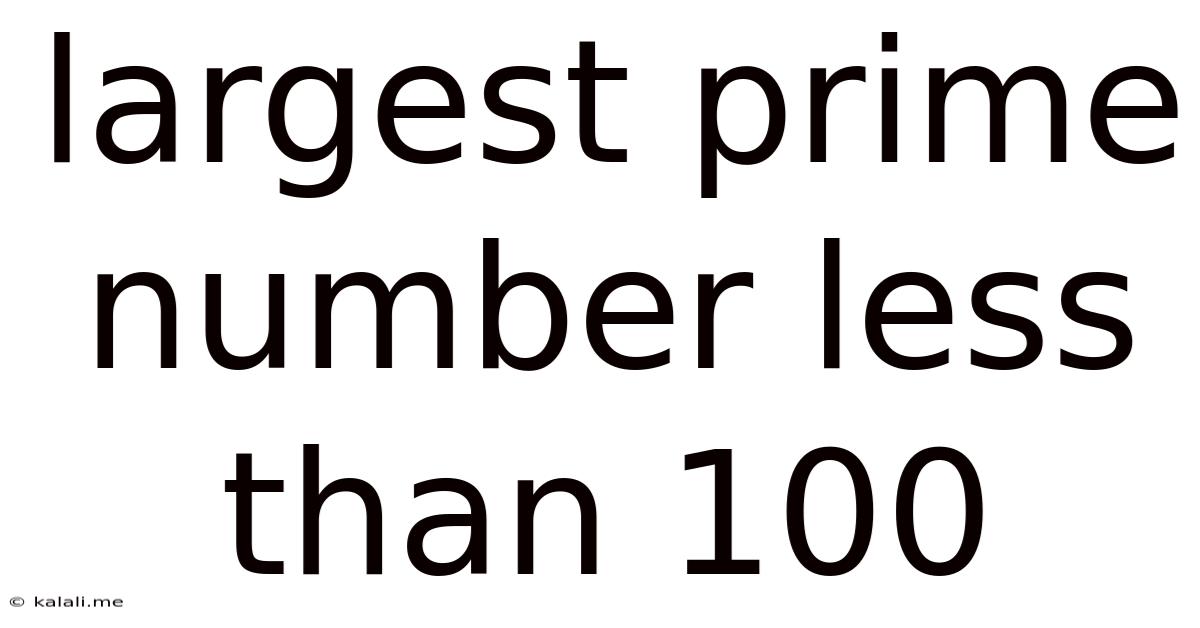Largest Prime Number Less Than 100
Kalali
Jun 11, 2025 · 3 min read

Table of Contents
The Largest Prime Number Less Than 100: Unveiling the Mystery of 97
Finding the largest prime number less than a given number might seem like a simple task, but it touches upon fundamental concepts in number theory. This article will explore the search for the largest prime number less than 100, explain what prime numbers are, and delve into some simple methods for identifying them. We'll also touch upon the significance of prime numbers in mathematics and computer science.
What are Prime Numbers?
A prime number is a natural number greater than 1 that has no positive divisors other than 1 and itself. In simpler terms, it's a number only divisible by 1 and itself. For example, 2, 3, 5, and 7 are prime numbers. The number 4, however, is not prime because it's divisible by 2. Understanding this definition is crucial for identifying primes.
Finding the Largest Prime Less Than 100
To find the largest prime number less than 100, we can use a process of elimination. We start by checking numbers downwards from 99. Let's explore some of these numbers:
- 99: Divisible by 3 and 9, therefore not prime.
- 98: Divisible by 2, therefore not prime.
- 97: After careful consideration, or by using a prime checking algorithm (explained below), we find that 97 is only divisible by 1 and itself. Therefore, 97 is the largest prime number less than 100.
Simple Methods for Identifying Prime Numbers
While checking divisibility for smaller numbers is relatively straightforward, it becomes more complex as numbers increase. Here are a couple of approaches:
-
Trial Division: This method involves checking if a number is divisible by any prime number less than its square root. If it's not divisible by any of these primes, it's a prime number. This is efficient for smaller numbers but becomes computationally expensive for very large numbers.
-
Sieve of Eratosthenes: A more efficient algorithm for finding all prime numbers up to a specified integer. It works by iteratively marking as composite (non-prime) the multiples of each prime, starting with the first prime number, 2.
The Significance of Prime Numbers
Prime numbers are far from just a mathematical curiosity. They hold significant importance in various fields:
-
Cryptography: Prime numbers are fundamental to many modern encryption algorithms, such as RSA, which secures online transactions and communication. The difficulty of factoring large numbers into their prime components underpins the security of these systems.
-
Computer Science: Prime numbers play a role in hash table design and other algorithms.
-
Number Theory: Prime numbers are central to many areas of number theory, a branch of mathematics dedicated to studying the properties of integers.
Conclusion:
The largest prime number less than 100 is 97. Understanding prime numbers and the methods used to identify them provides insight into fundamental concepts in mathematics and their crucial applications in modern technology. The quest for larger and larger prime numbers continues to fascinate mathematicians and computer scientists alike, driving innovation in computational power and cryptography.
Latest Posts
Latest Posts
-
Is Keri Russell Related To Kurt Russell
Jul 02, 2025
-
What Is Half Of 1 4 Teaspoon
Jul 02, 2025
-
How Many Cups In A Pound Of Hamburger Meat
Jul 02, 2025
-
Imagery Or Figurative Language From Romeo And Juliet
Jul 02, 2025
-
What Is A Quarter Of A Million
Jul 02, 2025
Related Post
Thank you for visiting our website which covers about Largest Prime Number Less Than 100 . We hope the information provided has been useful to you. Feel free to contact us if you have any questions or need further assistance. See you next time and don't miss to bookmark.